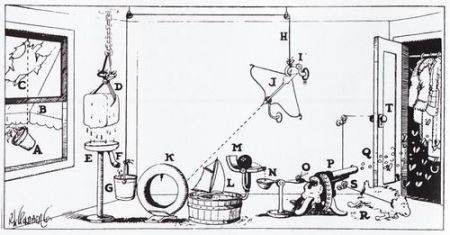Rube Goldberg machine
Here is how modern management works.

|
They wouldn't even lift a finger to save their own grandmothers from the Ravenous Bugblatter Beast of Traal without orders – signed in triplicate, sent in, sent back, queried, lost, found, subjected to public inquiry, lost again, and finally buried in soft peat for three months and recycled as firefighters.
1. Start with a process
Let's say we want to negotiate the terms of credit support under an ISDA Master Agreement.
This ought to be a salutary, utilitarian process, but for reasons explored in horrendous detail elsewhere on this wiki, it isn’t. Nevertheless, along with a great deal of iatrogenic wordsmithing, to successfully conclude a 2016 VM CSA, a negotiator must agree a list of fairly structured data points: Base and Eligible Currencies, Independent Amounts, Thresholds, Minimum Transfer Amounts, Valuation and Notification Times, Interest Rates for each Eligible Currency — that kind of thing: important, but snoreseville. Note: at the point of consensus ad idem, the negotiator has all this information in a perfectly replicable, digital format — just how the giant steampunk machine of financial services likes it.
Ok note that point: as of now, without even trying, we have exactly what we want, where we want it: structured digital data, suitable for piping around the organisation, able to be ingested into any database, free of any meddling substrate. We are in the home strait, are we not?
Allow me a quick observation here, readers. “Establishing an automated process to transmit data from one point to another across a network” is not a challenging proposition. It is not innovative. It is not difficult to do. It is the basic operating premise of network computing.
Buts story would not be worth the telling if we were going to do anything as sensible as that, would it? We have the makings of a good process; let us now break it.
2. Break it
For our loyal negotiator inputs this data not into MySQL, as you would expect, but into a Microsoft Word document. She then prints it out, onto paper, spends a couple of days wandering in around the organisation trying to find someone to sign that piece of paper — you know, with a biro — and then she scans the whole thing into .tiff format and converts it to email. Thus, we have taken a perfectly processable ASCII-encoded digital artefact, rendered it as an unprocessable analog on an expensive, perishable and eminently losable substrate (paper), re-digitised that as a flipping picture, and then sent it off to a team of school-leavers in Bucharest whose job it is to receive it, print it out, read it, and transcribe the contents into the collateral engine.
Hence the The Hitch-Hiker’s Guide to the Galaxy quote at the top.
3. Introduce reg-tech to “fix” it
This would be sad if it were not true. Enter the digital prophets